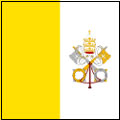ABOUT The Vatican City
 Country Briefs: Wealth not of nature but of art treasures is the mantra of this city that is perhaps the richest independent state so far, landlocked within the city of Rome and Italy.
Country Briefs: Wealth not of nature but of art treasures is the mantra of this city that is perhaps the richest independent state so far, landlocked within the city of Rome and Italy.
The northern border of the Vatican City opens the door for enchanting Vatican museums that parade exclusive range of Syrian, ancient Greek, ancient Roman and Egyptian relics; archaic and renaissance sculptures, paintings, tapestries and so forth.
With a mere area of 0.44 square kilometers the Vatican City is one of the European microstates that is situated on the Vatican Hill in the northwestern hemisphere of Rome. The Bishop of Rome or the Pope governs the approximate population of mere 925 people of Vatican. The Vatican is the sovereign territory of the Holy See and the residence of the Apostolic Palace i.e. the official residence of the Pope.
On reflecting over the past of the Vatican it is revealed that the Vatican City State, sovereign and independent is the survivor of the Papal State. From 1860 to 1870 during the struggle for Italian unification, the Papal States, covering an area of 44,030 square kilometers, served as a part of Italy.
In 1870 the Pope's holdings were left in a precarious situation. Due to the Italian law of 13th may 1871, the temporal power of the pope was repealed and the territory of the papacy was restricted to the Vatican and Lateran palaces and the villa of Castel Gandolfo.
From 1870 to 1929 the situation of Popes was like that of the last emperor of China who had no official status recognized by Italian government. The Popes never agreed to this kind of arrangement. However on 11th February 1929 the Lateran Treaty was signed between the Vatican and the kingdom of Italy.
As a result of this treaty under the premiership of Mussolini the autonomy of the Holy See was established along with granting special status to Catholicism in Italy.
On 11th October 1962 John XXIII inaugurated the first session of Ecumenical Council Vatican II and decided the policies for the modernization of Roman Catholic Church. The Vatican II modified many church practices.
On 26th August 1978, Cardinal Albino Luciani was proclaimed the new pope named John Paul I. But John Paul I was the pope for the shortest period ever. He died only after 34 days of his election.
His death led to the selection of Cardinal Karol Wojtyla as the John Paul II. Pope John Paul II was the first Polish Pope, also the first non-Italian pope elected since the Dutch Adrian VI of 1522-23.
On 3rd June 1985 the Vatican and Italy ratified a new church-state treaty known as a concordat. This treaty replaced the earlier signed Lateran Treaty of 1929 and affirmed the freedom of Vatican city thereby limiting number of privileges that the Catholic Church had in Italy an also its status as a state religion.
After the death of John Paul on 2nd April 2005, German cardinal Joseph Ratzinger was entitled the new pope.
The Vatican City Country
- Country: This division is the whole of the country, treated as a division for compatibility.
- HASC: Hierarchical administrative subdivision codes.
- Population: 1992 estimate.